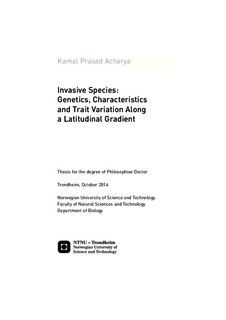| dc.contributor.advisor | Graae, Bente Jessen | nb_NO |
| dc.contributor.advisor | Pelabon, Christophe | nb_NO |
| dc.contributor.author | Acharya, Kamal Prasad | nb_NO |
| dc.date.accessioned | 2014-12-19T13:13:56Z | |
| dc.date.available | 2014-12-19T13:13:56Z | |
| dc.date.created | 2014-10-21 | nb_NO |
| dc.date.issued | 2014 | nb_NO |
| dc.identifier | 757086 | nb_NO |
| dc.identifier.isbn | 978-82-326-0464-7 (printed ver.) | nb_NO |
| dc.identifier.isbn | 978-82-326-0465-4 (electronic ver.) | nb_NO |
| dc.identifier.uri | http://hdl.handle.net/11250/245564 | |
| dc.description.abstract | Globalization during the second half of the 20th century has accelerated the introduction and the spread of non-native species. Introduced species is considered the second largest threat to biodiversity after habitat destruction. It is therefore necessary to understand what makes introduced species successful in novel environments. Furthermore, introduced species provide unique opportunities to study the evolutionary processes that are involved in invasion success. We studied genetics, and evolution of higher phenotypic plasticity and local adaptation after introduction of one of the highly invasive species in Europe, Impatiens glandulifera, and compared trait variation in native and invasive Impatiens species along a latitudinal gradient in Europe. We found evidence of multiple introductions of the invasive I. glandulifera in Europe. Despite multiple introductions, there was a strong loss of genetic diversity in the invasive populations compared to native populations from Kashmir, India. Furthermore, loss of genetic diversity in the invasive populations does not constrain evolution of adaptive genetic differentiation. In another study, we did not find evidence that the species developed increased plasticity after introduction. A comparative study between a native, Impatiens noli-tangere, and an invasive species, Impatiens parviflora, showed that latitude has stronger effect on the performance of the invasive species in terms of plant height than on the native species. Surprisingly, the invasive species performed better under low nitrogen compared to high nitrogen conditions along the latitudinal gradient indicating that the invasive species is not constrained by low nitrogen conditions. All together these findings suggest that invasive species loose genetic variation, and do not adapt into more aggressive invasives, but they do evolve rapid adaptations to broad-scale environmental conditions in their introduced range | nb_NO |
| dc.language | eng | nb_NO |
| dc.publisher | Norges teknisk-naturvitenskapelige universitet | nb_NO |
| dc.relation.ispartofseries | Doktoravhandlinger ved NTNU, 1503-8181; 2014:276 | nb_NO |
| dc.title | Invasive Species: Genetics, Characteristics and Trait Variation Along a Latitudinal Gradient | nb_NO |
| dc.type | Doctoral thesis | nb_NO |
| dc.contributor.department | Norges teknisk-naturvitenskapelige universitet, Fakultet for naturvitenskap og teknologi, Institutt for biologi | nb_NO |
| dc.description.degree | PhD i biologi | nb_NO |
| dc.description.degree | PhD in Biology | en_GB |

